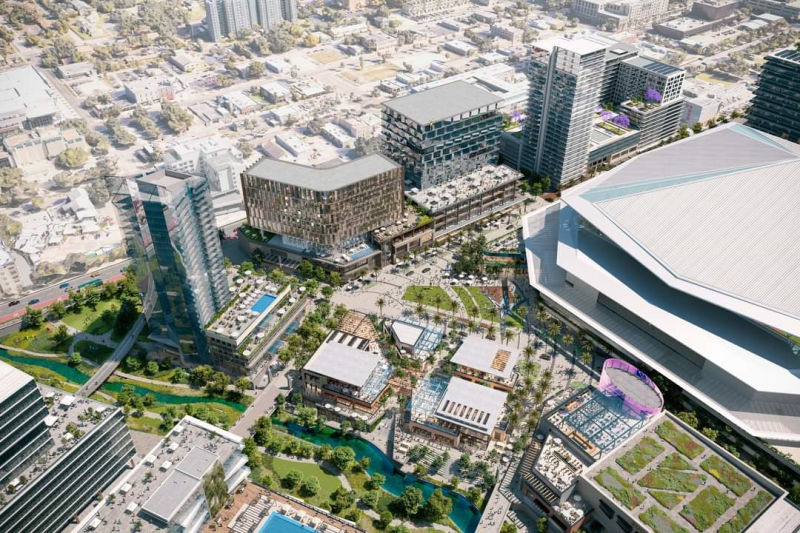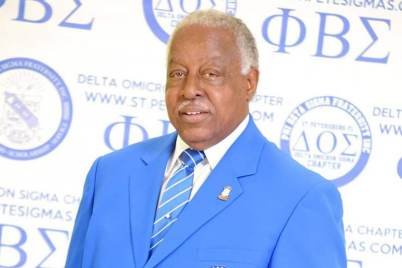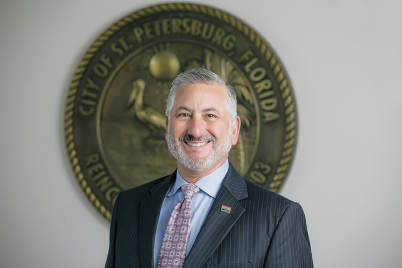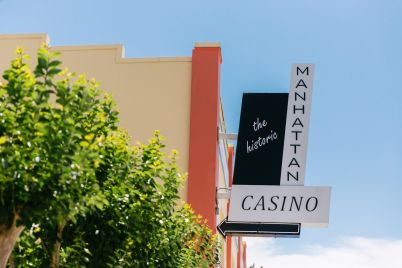As outlined in the development terms released on April 25, the public will contribute funds in four phases for a total of $130 million by 2035 while Rays-Hines will pay a maximum of $50 million for the same period. [Rays-HInes]
BY FRANK DROUZAS | Staff Writer
ST. PETERSBURG — As the city takes steps to redevelop and revitalize the Gas Plant district and Tropicana Field, the project has met with some opposition. NoHomeRun.com is hosting a series of community conversations that oppose the current proposal from the Rays-Hines Development group.
Karyn Mueller and Alan DeLisle held a Zoom meeting on May 6 to discuss the proposal’s details and encourage city council members to vote “No” on it. They plan to have six Zoom meetings, one every Monday night, until the city council votes on the project. Mueller said residents won’t get to vote on the crucial project, so she urged them to tune into the weekly meetings and write or call their council members with their input.
Mueller, who lives in Campbell Park, previously worked as a professional engineer for the City of Miami, reviewing construction plants for public works. She recently volunteered on the Community Benefits Advisory Council, a non-partisan board that advised the mayor, city council and citizens on the Gas Plant district redevelopment project.
“As I have learned more and more about the current Rays-Hines development proposal,” she said, “I have significant concerns about moving forward into a 30-year partnership with Rays-Hines.”
In outlining the current proposal, Mueller noted that Rays-Hines is offering $105 million to purchase the 64 acres adjacent to Tropicana Field. They are asking for $287.5 million of a stadium subsidy from residents and $130 million in public funding for infrastructure. The group also requests a $312.5 million stadium subsidy from Pinellas County. The city will have to borrow the money by taking out bond debt and paying it back over 30 years.
“The total amount of debt for the stadium subsidy ends up being approximately $700 million,” she explained, adding that if Pinellas finances the contribution to Rays-Hines, it will end up being nearly $587 million.
Citing an article in the Tampa Bay Times last October, Mueller said the total between the city and the county after financing would be about $1.3 billion — almost double the $700 million officials initially said it would cost. Though the Rays-Hines group was chosen, the proposal is still not a “done deal,” as the development terms were only released on April 25.
“Before April 25, no one knew what the final terms of the agreement were,” she said, “and therefore, they should not have endorsed the project without knowing the details of the deal.”
The city council will vote in two meetings in July to approve or deny the proposal. The county commission also must vote but has yet to schedule dates.
When it comes to financing new stadiums, professional sports teams and cities employ various strategies to avoid public referendums, and one of the approaches they take is direct approval by elected officials without going through a public referendum. The city will pay back the bonds with tax increment financing (TIF) funds — a public financing method used as a subsidy for redevelopment and other community improvement projects. The original intent of the TIF program was to stimulate private investment into a blighted area designated to need economic revitalization, she said.
Rays-Hines proposed using TIF funds from an Intown Community Redevelopment Area (CRA), which covers some of the city’s most valuable real estate, including the high-rise buildings along Central Avenue and properties on Beach Drive. The Intown CRA, established in 1986, sought to revitalize the then-economically disadvantaged downtown area. The city is proposing extending the CRA until 2042.
“That means that half of the property tax from that CRA — half of the property taxes from those valuable high-rises and commercial real estate on Central Avenue and Beach Drive — will be diverted to pay for the stadium bonds until 2042,” Mueller pointed out, “and then the money starts coming out of the general funds.”
As outlined in the development terms released on April 25, the public will contribute funds in four phases for a total of $130 million by 2035 while Rays-Hines will pay a maximum of $50 million for the same period, she said. Development includes residential units, affordable/workforce housing and commercial, office and retail buildings. Of the projected 1,250 affordable/workforce units, a minimum of 600 units must be on-site, with at least 100 units at 80 percent AMI (area median income) or below and 100 units at 60 percent AMI or below.
“That’s a pretty low number of affordable housing units on-site,” she said, “and only 100 will be built by 2028. The remaining 300 don’t have to be built by 2030, and 100 have to be [for ages] 55 and up.”
Mueller said the proposal starkly contrasts the development schedule for the stadium and the real estate. It lists detailed phases for stadium construction — with a timeline of an April 2028 completion — and only starting dates and no other details for the real estate.
“I think that this conveys where the priorities are as far as what gets built first and how soon it gets built,” she said.
DeLisle, a former St. Pete city administrator and development expert, bluntly called the proposal “a very bad project.” He agreed that there is an imbalance in the proposal as the stadium is slated to be completed by 2028, yet the rest of the development wouldn’t be completed until 2054 — “and that is only the minimum development,” he noted.
He said there are so many outs that the developer has to not produce or not perform that the city could be left with very little other than the stadium, which is DeLisle’s biggest concern.
In DeLisle’s opinion, the flaws in the agreement started very early when the city decided to have a different timeframe for the stadium than for the rest of the development, which he calls the non-stadium development. They are on totally different timeframes and are funded at other times. The city’s investment is all upfront, and the developer’s investment is over time.
Being in the development business for 45 years, DeLisle said, “You always want to make sure that the private developer is moving at the same speed as the public and most of the time, you want the private sector investing first and then the public sector comes in. This is completely reversed.”
The city surrendered to how the Rays wanted to frame the deal, separating the stadium negotiations from the development of the entire Tropicana site, conceding leverage, he pointed out.
“The mistake was made early when the mayor (Ken Welch) and many of the council members really just kind of bought into keeping the Rays,” DeLisle said, “and didn’t see the project as the former mayor did — Mayor [Rick] Kriseman — as a way to keep the Rays but also make sure that the city got what it needed with development around the stadium, i.e., office, jobs, etc.”
He also explained that Mayor Welch chose the Rays-Hines group without negotiating a term sheet before the selection announcement.
“You never pick out a developer until you work out the deal first,” he said. “So that was a huge mistake.”
The city is giving away land and paying for all the infrastructure — $130 million — related to the development in and around the stadium, DeLisle noted, pointing out that this is unheard of in a development market as strong as St. Pete and a site adjacent to such a robust and vital downtown. He also disagrees with the current development agreement, which allows for “parcel developers” — developers other than Rays-Hines — to come in and complete a particular “parcel” for Rays-Hines.
“Instead of dealing with one entity, you could be dealing with 10 or 15!” he said. “That is not a good position for a city to be in.”
DeLisle said the agreement contains language that gives the developer several “outs,” including “excusable development delays.” They can even delay the minimum development if there are delays on the stadium, which the developer controls. A developer can also reject parcels for several reasons.
Before this proposal, DeLisle recalled that in the conversations, many of the advocates for south St. Pete development required a 20 percent to 30 percent minority business participation rate.
“I almost fell off my chair when I saw 10 percent in this deal!” he said. “And 10 percent is the goal. Ten percent is not required; it’s just a goal. Now, in the Midtown [Development] deal that I negotiated, we were doing 20 percent across the board, and it was a requirement.”
He raised other questions, such as what happens if the current owner sells the Rays. Would the city get paid back for its investment, or would ownership obtain all the increased financial value? Another shortcoming of the current proposal is that there are no mentions of Grow Smarter Industries, the Innovation District, local small businesses and office requirements, the Arts District or Deuces Live.
He explained that the developer and parcel developers must pay a minimum of $50.4 million for property on site in the first 12 years of the agreement term. These provisions mean the city pays out a minimum of approximately $80 million in infrastructure during this time, not to mention $287.5 million for the stadium up front and $174 million in land value—and the developer doesn’t have to pay anything until year 12. Even after paying for this land, there is no development requirement until year 10, and it is only a third of the minimum.
One section of the agreement states that half of the 1,250 affordable housing units must be built on-site “or as may be mutually agreed upon by developers and city.”
“Ladies and gentlemen, it may not be 600 units!” DeLisle said. “It might be one because the mayor can decide to make a different deal on that later on, based on that language.”
DeLisle said he can’t believe the raw deal the city is getting on infrastructure.
“I just can’t believe that the roads, the parks, all the green space, the trails, the utilities, all of that is being paid for by the city,” he said. In a project like this, those are developer responsibilities.
“Special assessment, letting the developer off the hook to pay anything for infrastructure. How come the city doesn’t benefit from that? And then the impact of the special assessment on affordability is going to drive up the cost of rent because the property owners are going to have to pay a special assessment.”
DeLisle said that when he worked for the city, people were in an uproar about the amount of open space. Under the agreement he worked on, there were 24.7 acres of parkland, but this new agreement only allots 10 acres.
DeLisle also noted that the development agreement states that the city cannot terminate the Rays-Hines group for any reason.
“When we had Midtown, if [the developer] failed to perform, they got terminated. That’s not the case here,” he said. “Very imbalanced; fundamentally flawed. You can’t make this better by tinkering on the margins, which is what the city has been doing. You have got to go back to the table and make this a better deal for the city and the city residents.”
Click here to watch the May 6 and May 13 Zoom meetings and get the link for the May 20 meeting.









When I was told that this article was in the Weekly Challenger I had to see it for myself. The writer must be extended our gratitude for his willingness to write an article based totally on truth, regardless of the toes stepped on. Facts are facts, this Development Agreement is horrible for St. Petersburg, period. Former city administrator and expert development consultant Alan DeLisle very clearly laid out a number of damning reasons this deal should NOT proceed as presently written.
BASEBALL, YES! THIS DEAL, HELL NO!!!
A careful review of Mr. DeLisle’s examination of the Development Agreement between Rays/Hines and the City of St. Petersburg suggests gross incompetence, negligence and abuse of authority on the part of the mayor.
I tuned into the zoom meeting when Ms. Mueller and Mr. DeLisle discussed the Development Agreement and listened intently. Afterwards, I wondered, “How in the hell did a supposedly intelligent mayor push something like this on the residents?” Mr. DeLisle reportedly said, “No deal is perfect, but no deal should be this BAD for a city and its residents.”
BASEBALL, YES! THIS DEAL, HELL NO!!!
We’ve been talking about this on The JP Peterson Show podcast/Livestream since the deal was announced. This is a bad deal for Fans (failed location meaning continued low revenues opps) and bad for St Pete. We all want the Rays to stay and MLB does not want to leave the 11th largest market. Hillsborough officials have said there is still a deal to be done if Rays want to do a true public/private partnership not just getting a blank check like this deal. Point being, if this deal is voted down it doesn’t mean the Rays are leaving. Perhaps it leads to new ownership and a reasonable/smart development in Hillsborough. Maybe going back to the Hard Rock/Fairgrounds concept? Don’t believe the false narrative and the “urgency” that this needs to be rammed through without careful consideration.